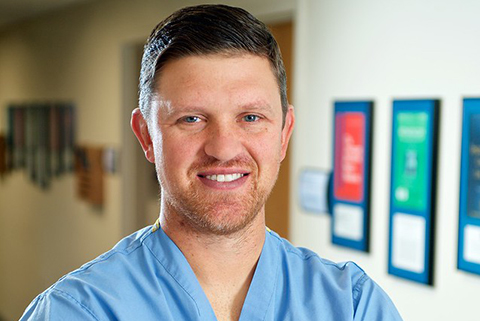Having surgery or living with pain shouldn’t be the only options for patients with knee osteoarthritis (OA). “Many patients aren’t given non-surgical options at other practices, and putting up with knee pain often leads to the knee getting worse,” says Rodney Benner, MD, an orthopaedic surgeon and head of the OA Knee Rehabilitation Program at Shelbourne Knee Center.
Physical therapy is the mainstay of treatment for knee OA at Shelbourne Knee Center, with cortisone injections and medications sometime used as adjunct therapy. Total knee arthroplasty (TKA) is reserved for patients who do not achieve adequate pain relief through the OA Knee Rehabilitation Program.
Shared Decision-Making
The initial visit to Shelbourne Knee Center includes a discussion of what the patient has already tried and what has and has not been effective. “Then we lay out the possibilities and choose the best treatment(s) based on a shared decision-making model with the patient,” says Dr. Benner.
Physical Therapy Works Best
“Many doctors will tell patients that physical therapy is not going to make the arthritis go away and shouldn’t help with symptoms. Our data shows that physical therapy does help arthritic knees get better,” says Dr. Benner.
Results on 396 knee OA patients in Shelbourne Knee Center’s OA Rehab Study (1) show that most patients improved with physical therapy:
- Only 24% went on to have a TKA.
- Both range of motion (ROM) and patient-reported pain, symptoms, activities of daily living, ability to participate in sport, and quality of life improved.
The OA Knee Rehabilitation Program focuses on ROM first, to restore knee extension and then knee flexion equal to the normal knee. This is followed by strengthening to provide good leg control and improve everyday function.
Recommended low-impact activities to increase conditioning and improve exercise tolerance include using a stationary bike, elliptical machine, stair-master, or rowing machine, or swimming. “We don’t recommend walking, because it requires you to do same amount of work on both legs. The stiff, weak knee won’t be able to keep up with the normal knee. On a bike, for example, you can pedal hard with one knee and let the other come along for the ride.”
Cortisone Injections and Medications
Cortisone injections and medications, primarily NSAIDs, control symptoms and decrease swelling and pain. “We usually start with a cortisone injection, which gives most people an interval of relief. Sometimes the interval is short and sometimes it is long,” says Dr. Benner. The cortisone injection relieves pain enough for the patient to begin physical therapy. Oral steroids are given for patients who can’t tolerate an injection.
NSAIDs are the best type of medication for decreasing knee pain, says Dr. Benner. While some data may show that a particular NSAID is most effective, what’s best in clinical practice varies among patients. “Some people like naproxen because you only have to take it twice a day. Some people say naproxen doesn’t help but ibuprofen works,” says Dr. Benner. Prescription NSAIDs are an option for patients who have GI problems from OTC NSAIDs or need longer relief.
Surgery as the Final Option
For patients who don’t get enough relief through physical therapy and go on to TKA, the pre-op improvements made during the OA Knee Rehabilitation Program facilitate a better surgical outcome and a faster, easier recovery.
For more information about non-surgical options for knee OA, please call 888-FIX-KNEE.
Reference
- Shelbourne DK. Nonoperative Treatment of Knee Osteoarthritis, presentation at the Herodicus Society Meeting, June 2018.

